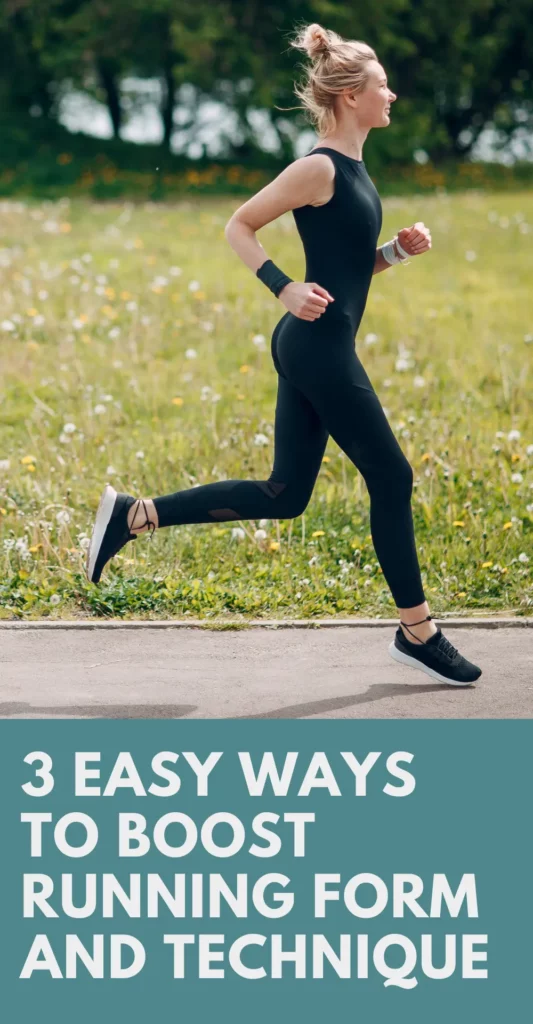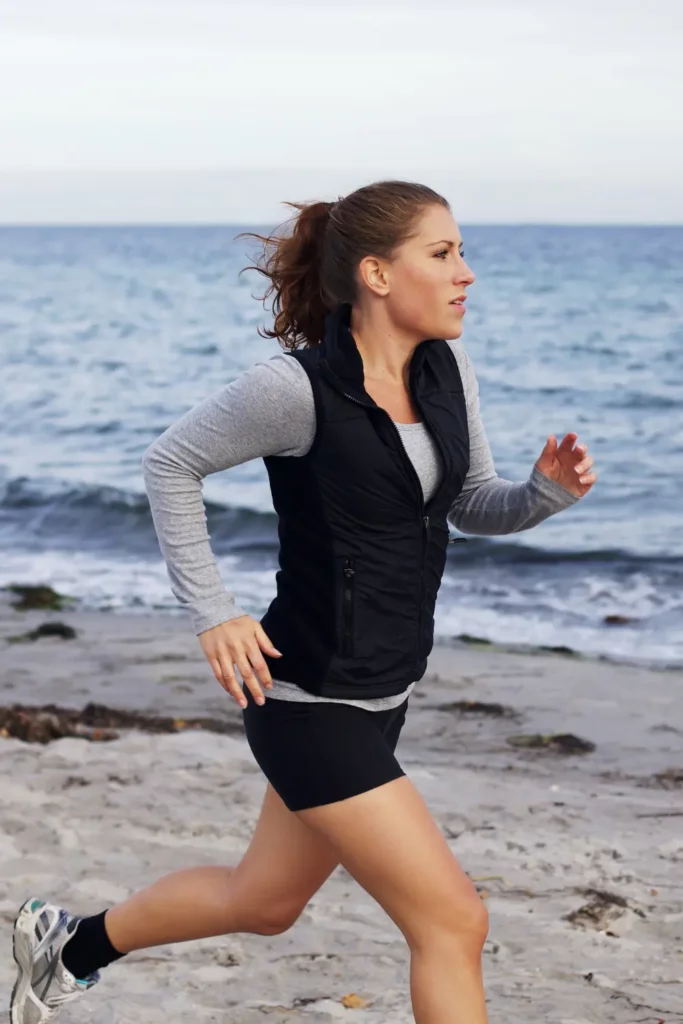If you’re looking to enhance your running form and technique, you’re in the right place!
Improving your running form is essential for both beginner and experienced runners.
I remember when I first started running, I didn’t even know there was a proper way to run.
I just headed out on my run and hoped for the best!
How wrong I was!
When you run with proper running form and technique, you run in a way that uses the least energy.
It helps you run faster and reduces the chance of getting injured.
So, it’s like learning the best and safest way to run!
Good running form and technique also has the potential to enhance your running experience and help you achieve your running goals.
You are more likely to achieve your next PB, for example, if you run in the most efficient way possible.
In this guide we’ll look at 3 easy ways to boost your running form and technique.
So, lace up your running shoes and let’s get going!
We’ll look at:
- What is running form and technique?
- What are the benefits of proper running form and technique?
- 3 easy ways to boost your running form and technique
Ready?
Let’s get started

What is running form and technique?
Running form and technique is the way you move your body when you run.
It’s all about using your arms, legs and core to run in the most efficient way possible.
- Running form – this refers to how you hold your body when running. It includes things like your posture, how your feet land and how your arms swing.
- Running technique – this refers to the way you run. It includes your step rate, your stride rate and how you breathe when running.
When it comes to adopting proper running form and technique, remember, it’s not about perfection but progress!
Making adjustments to your running form might take time, but don’t try to change everything at once!
Instead, make gradual adjustments and allow your body to adapt.
Related: What muscles does running work? An inside look at running performance
What are the benefits of proper running form and technique?
Here the benefits of proper running form and technique.
#1 Helps to reduce the risk of injury
Adopting proper running form and technique drastically reduces the risk of common running injuries like IT band syndrome, runner’s knee and shin splints.
According to one study, it is predicted that over 50% of recreational runners sustain a running-related injury per year, with half of those injuries occurring at the knee.
The substantial proportion of work during running is involved in opposing gravity.
By maintaining a balanced stride, you place less stress on your muscles and joints, such as your knees, ankles and hips, when you run.
#2 Improves running effiency
Proper running form ensures you use your energy efficiently when running.
By optimising your body’s biomechanics, you minimise energy wastage and move more efficiently.
This means you can run longer and faster with less effort.
#3 Increases speed
When you run with better form, you can run faster.
Good running technique means you engage your core, drive your arms and optimise your stride length and cadence.
All these factors play a crucial role for running speed.
#4 Increases endurance
Better form means you can run for longer distances without fatigue setting in as quickly.
You can maintain your pace for more extended periods, whether you’re training for a marathon or just looking to improve your overall fitness.

#5 Reduces muscle soreness
Proper running form distributes the workload more evenly across your muscle groups.
This can help to reduce post-run muscle soreness and improve recovery time, making it easier to get back out on the road or trail sooner.
#6 Improves mental focus
Paying attention to your form and technique requires mental focus.
This can help distract you from the discomfort of running and make your workouts more engaging.
#7 Boosts confidence
As you improve your form and technique, you’ll likely feel more confident as a runner.
This can translate into setting and achieving more ambitious running goals, which can be incredibly motivating and fulfilling.
#8 Improves posture
Running with good form can lead to improved posture in your everyday life.
This can help prevent back pain and reduce the risk of posture-related issues which can so often occur in modern life.
#9 Enhances breathing
Proper running form encourages more efficient breathing.
This can lead to better oxygen intake and improved overall cardiovascular fitness.
#10 Improves overall health
Running with good form and technique has numerous health benefits, including lower blood pressure and improved cardiovascular health.
It can also contribute to better mental health by reducing stress and promoting the runner’s high.
Related: 5 key principles of proper running form and technique (and why they matter)

3 easy ways to boost your running form and technique
#1 Wear the right running shoes
Wearing the right running shoes is an important first step in improving your running form and technique.
A well-fitting pair of running shoes will help you achieve an efficient gait and minimise the risk of injury.
There are a few factors that you need to consider when choosing your running shoes.
- Comfort and fit
- Pronation type
- Terrain and distance
Comfort and fit
Your running shoes should be comfortable from the moment you put them on.
Make sure they have enough room for your toes, snug but not tight around the heel, and ample arch support.
Try different brands and models to find the perfect fit.
Brands like Brooks offer a 100 day money-back guarantee should you not be satisfied with your running shoes.
Pronation type
Your foot’s pronation type is how your foot rolls when it strikes the ground.
There are three pronation types:
- Neutral – when your feet and ankles stay properly aligned when you run.
- Overpronation – occurs when the foot rolls inward when your foot makes contact with the ground.
- Underpronation – occurs when the foot rolls outward when your foot make contact with the ground.
It’s crucial you identify your pronation type and find running shoes that offer proper support.
Terrain and distance
Consider where you’ll be running most often.
Different types of terrain (road, trails, track) and distances (sprinting and long distance) require different types of shoe.
For example, you wouldn’t wear the same running shoes when road running and trail running.
Ensure your shoes match your running environment and goals.
Related: 5 key principles of proper running form and technique (and why they matter)
#2 Focus on your posture
Having a strong core and good posture are essential components of proper running form.
A strong core stabilises your body and helps maintain balance, while good posture ensures efficient energy transfer and reduces the risk of injury.
Here’s how to improve your core strength and posture:
- Incorporate core exercises
- Pay attention to your posture
- Practice breath control
Incorporate core exercises
Core exercises like planks, Russian twists and leg raises are great core exercises to include in your training routine.
These exercises target your abdominal muscles, obliques and lower back – all of which play a crucial role in maintaining a stable running posture.
Pay attention to your posture
Pay attention to your posture during your daily activities.
Stand and sit up straight to develop better posture. When running, keep your chest open, shoulders relaxed and engage your core.
Imagine there is a balloon attached to a piece of string that is pulling you upward from the top of your head to encourage an upright stance.
Practice breath control
Proper breathing technique helps support your core and maintain your posture.
Focus on deep diaphragmatic breathing rather than shallow chest breathing.
Inhale deeply through your nose, allowing your belly to expand, and exhale through your mouth.
This will provide your muscles with ample oxygen, helping them function optimally.
Related: 9 best core exercises for runners (and how to do them properly)

#3 Optimise your cadence and stride length
Your running cadence (also known as your stride rate) and stride length are vital components of your running technique.
Balancing these two aspects can significantly impact your efficiency and overall running experience.
Here’s how to optimise your cadence and stride length.
Cadence
Running cadence is the number of steps you take per minute. Aim for a cadence of around 170-180 steps per minute.
A higher cadence helps reduce the risk of overstriding and excessive impact on your joints.
To help you improve your cadence, try using a metronome app during your runs.
This will help you maintain a consistent rhythm when you run.
Stride length
Your stride length is the distance covered when you take two steps forward, one with each foot.
If your foot lands too far in front of your body (known as overstriding), you reduce your body’s ability to absorb the force of your landing.
Over time this can lead to shin, knee and hip injuries.
A stride that’s slightly shorter than your natural gait will help prevent these issues.
Focus on landing with your foot underneath your body to reduce the risk of injury and enhance your running efficiency.
Related: Running form and technique: 4 simple tips to improve running form on your next run
- 5 things I wish I’d known before returning to running - March 3, 2024
- Running 20 minutes a day: Benefits + how to start - January 27, 2024
- How to run your first 2 hour half marathon - January 16, 2024
